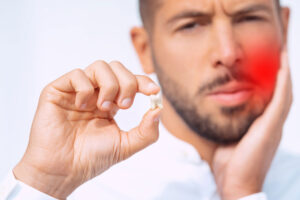Maintaining excellent oral hygiene is crucial to keeping your teeth and gums healthy. However, it’s not just about brushing and flossing—it’s about doing it correctly. At Just Pull It Emergency Dental Clinic, led by Dr. Jeff Hameroff in Spring Hill, Lutz, Tampa, and Zephyrhills, Florida, we often see patients with dental emergencies that could have been avoided with proper daily care. Here’s a detailed guide to ensure you’re getting the most out of your brushing and flossing routine.
Brushing: The Foundation of Oral Care
Brushing is the cornerstone of daily oral hygiene, but technique matters more than you might think. To ensure your brushing is effective and not harmful to your teeth and gums, follow these steps:
- Choose the Right Toothbrush
Your toothbrush is more than a cleaning tool—it’s an extension of your oral health routine. Opt for a soft-bristled toothbrush with a head that comfortably fits your mouth. An electric toothbrush can also be a great option for more efficient cleaning, particularly for those who may have difficulty reaching all areas of their teeth. - Use the Right Toothpaste
Fluoride toothpaste is essential for preventing tooth decay. However, if you have sensitive teeth, there are specialized toothpastes that can help reduce discomfort. Fluoride strengthens enamel, the outer protective layer of your teeth, and helps prevent cavities. - Brush for the Correct Amount of Time
Brushing for two minutes, twice a day, is widely recommended, but how you spend those two minutes matters. Divide your mouth into quadrants and spend 30 seconds brushing each section thoroughly. Make sure to brush all surfaces: the outer, inner, and chewing surfaces of each tooth. - Master the Brushing Technique
Hold your toothbrush at a 45-degree angle to your gums and use short, gentle strokes. Vigorous scrubbing may wear down your enamel and irritate your gums. Instead, focus on the technique: small, circular motions that clean plaque and bacteria without damaging the teeth. - Don’t Forget Your Tongue
Bacteria love to hide on the surface of your tongue, leading to bad breath and contributing to gum disease. After brushing your teeth, give your tongue a gentle scrub to remove harmful bacteria. - Rinse Your Toothbrush, Not Your Mouth
After brushing, it’s tempting to rinse out your mouth, but doing so washes away the fluoride from your toothpaste. Instead, spit out the excess and let the fluoride continue to protect your teeth.
Flossing: The Essential Complement to Brushing
Brushing cleans the surfaces of your teeth, but it can’t reach the tight spaces between them. This is where flossing comes in. By removing food particles and plaque from between your teeth, flossing helps prevent gum disease and tooth decay in these hard-to-reach areas.
- Choose the Right Floss
There are various types of floss available, including waxed, unwaxed, and dental tape. Choose one that fits easily between your teeth without causing discomfort. For people with braces or dental work, a floss threader or water flosser may be a more effective option. - Proper Flossing Technique
Break off about 18 inches of floss and wind it around your middle fingers, leaving about two inches to work with. Gently guide the floss between your teeth, being careful not to snap it into your gums. Use a gentle, back-and-forth motion and curve the floss around each tooth in a C-shape to remove plaque from under the gumline. - Flossing Frequency
Flossing once a day is sufficient for most people, but if you’ve eaten something particularly sticky or fibrous, you may want to floss more frequently. The key is consistency—flossing daily helps maintain the health of your gums and keeps plaque from hardening into tartar. - Don’t Neglect Your Back Teeth
It’s easy to focus on the front teeth when flossing, but the back teeth are just as important. These are often the site of cavities and gum disease because they’re harder to reach. Make sure to floss all the way back to ensure a thorough clean.
When to Brush and Floss: Timing Matters
Many people brush first thing in the morning and last thing at night, which is a solid routine. However, if you snack frequently or consume sugary foods or drinks throughout the day, you may need to brush more often to prevent plaque buildup.
Before or After Meals?
For those who enjoy acidic foods or drinks, such as citrus fruits or soda, it’s essential to wait about 30 minutes before brushing. Acids can temporarily soften enamel, and brushing immediately after can wear it down. Instead, rinse your mouth with water and brush later.
Common Mistakes to Avoid
Even with the best of intentions, it’s easy to fall into bad habits that could harm your oral health. Here are a few common mistakes to avoid:
- Using a Toothbrush for Too Long
Replace your toothbrush every three to four months, or sooner if the bristles are frayed. A worn-out toothbrush won’t clean your teeth effectively and can harbor bacteria. - Skipping Flossing
Flossing is just as important as brushing, yet many people skip it altogether. Plaque can quickly harden into tartar, leading to gum disease and other dental problems. - Brushing Too Hard
Hard brushing can wear down enamel and irritate your gums. Remember, it’s about technique, not force.
Professional Care: When Brushing and Flossing Aren’t Enough
While proper brushing and flossing are the foundation of oral health, professional dental care plays an equally important role. Regular cleanings and exams allow Dr. Jeff Hameroff and the team at Just Pull It Emergency Dental Clinic to identify issues before they become emergencies.
At Just Pull It, we often treat patients dealing with the aftermath of improper brushing and flossing. Whether it’s a sudden toothache or a more severe dental infection, emergency situations can often be traced back to inconsistent or ineffective oral care routines. Regular dental visits can help prevent these emergencies, but we’re always here when you need us.
Achieving Long-Term Dental Health
Ultimately, maintaining your oral health is about establishing consistent habits and using the right techniques. By brushing and flossing properly and visiting your dentist regularly, you can prevent the most common dental problems, like cavities and gum disease, from developing into emergencies. Just Pull It is committed to helping our community in Spring Hill, Lutz, Tampa, and Zephyrhills maintain healthy, happy smiles—one brushstroke at a time.
Preventing dental emergencies begins with everyday habits. Proper brushing and flossing aren’t just about avoiding cavities—they help protect your gums, keep your enamel strong, and prevent issues that could lead to dental emergencies. Make these habits part of your daily routine and reduce the likelihood of needing emergency dental care in the future.
Sources:
- Soderholm, G. N. (2015). The Importance of Toothbrushing Techniques in Oral Health. Journal of Dentistry.
- Haffajee, A. D., & Socransky, S. S. (2006). Dental Plaque and Its Role in Oral Health. Clinical Microbiology Reviews.
- Marinho, V. C., et al. (2003). Fluoride Toothpaste for Preventing Dental Caries. Cochrane Database of Systematic Reviews.

































